
South Tufa Trail and Mono Lake County Park
Birding Around Las Vegas, Favorite Places Far Away

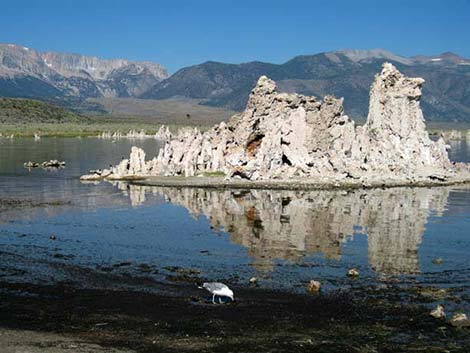 Offshore tufa tower and California Gull eating alkali flies |
Overview Located along the east side of the Sierra Nevada Mountain Range, and perhaps better known for the tufa towers and western water wars, there are two main birding areas: the South Tufa Trail and the Mono Lake County Park Boardwalk. Mono Lake provides salty habitat for billions of alkali flies and brine shrimp. The flies and shrimp, in turn, are food for many thousands of grebes, ducks, gulls, shorebirds, and other species, some 300 species and millions of individuals in all. Each spring, about 50,000 California Gulls breed on the big island in the lake, and about 400 endangered Snowy Plovers nest on the alkali flats on the northeast shore. In mid-summer, thousands of Wilson's Phalaropes and Red-necked Phalaropes stop during their migration to fatten up; and in the fall, nearly two million Eared Grebes join the food feast. Ducks, geese, and swans also stop here during migration. Link to Mono Lake Area Map , County Park Boardwalk Trail, or South Tufa Trail Map. |
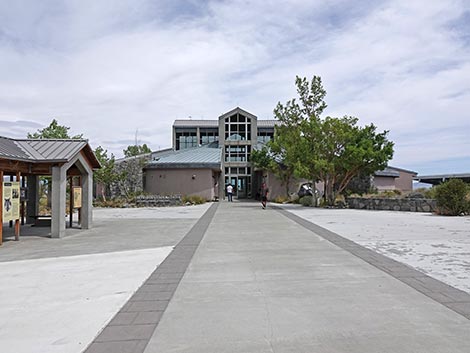 Mono Basin Visitor Center, National Forest Scenic Area |
Description Mono Lake is set in a picturesque valley on the east side of the Sierra Nevada Mountains in eastern California. Like many of the lakes east of the Sierras, Mono Lake sits in an enclosed basin with no natural outflows, and as a result, the water is salty. Springs in the lakebed are marked by tufa towers, which are a calcium-carbonate precipitate resulting from mixing calcium-rich spring water with carbonate-rich lake water. As water levels have declined, some tufa towers were exposed. Birds rest and nest on the tufa towers. There is also a large island in the lake that ground-nesting birds (especially the California Gull) use for nesting. |
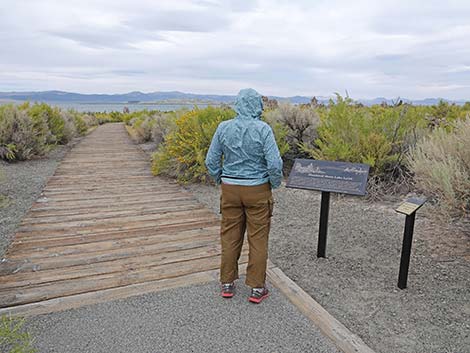 Accessible trail at South Tufa Towers Trail (view N) |
Because the water is salty, there is no riparian fringe on the lake except where streams flow in. There is a stream at Mono Lake County Park on the northwest side of the lake with cottonwoods, willows, and other trees and shrubs, and there is a bit of a marsh where the stream flows into the lake. Otherwise, the lake edge is barren or has a few salt-tolerant shrubs. Above the lake, the dominant plant in this high-elevation desert is sagebrush, and there are pines in the mountains surrounding the lake. The South Tufa Area, located on the southwest side of the lake, protects one of the largest collections of tufa towers. A self-guided nature trail, the South Tufa Towers Trail, runs down through the sagebrush scrub (sagebrush with lots of greasewood, saltbush, and rabbitbrush) to the edge of the lake. The shrubs along the trail make good birding for landbirds (e.g., Rock Wrens, Sage Thrasher, Loggerhead Shrike, Red-tailed Hawk, Northern Harrier, Common Nighthawk, Black-billed Magpie, Sage Sparrow, and Western Meadowlark). |
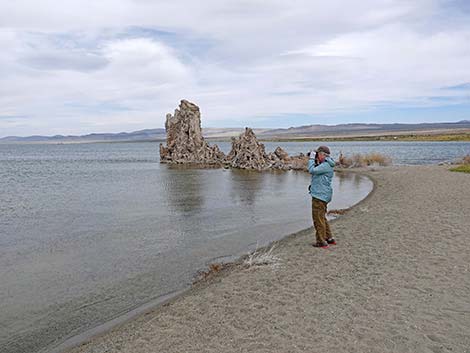 Birding along the South Tufa Towers Trail (view SE) |
The lake and tufa towers can be covered with waterbirds (phalaropes, grebes, gulls, waterfowl, and a few predators like Peregrine Falcon and Osprey). The shoreline is a good place to look for shorebirds (American Avocet, Marbled Godwit, Western Sandpiper, Spotted Sandpiper, Willet, and Black-necked Stilt). During migration, Ruddy Ducks, Green-winged Teal, Mallards, Canada Geese, and Tundra Swans can be common. Mono Lake County Park has an easy boardwalk trail that runs down through cottonwoods and willows to a marsh at the edge of the lake (with more tufa towers). From the end of the boardwalk, birders can see phalaropes, waterfowl, and grebes feeding in the water, and shorebirds feeding on the little delta at the edge of the lake. The cottonwoods and grassy areas in the park, proper, also make for good birding (watch for flycatchers, tanagers, and warblers). Wilson's Snipe breed in the wet meadows, and Red-Winged Blackbird, Song Sparrow, Common Yellowthroat, Killdeer, Snowy Egret, and Green Heron are common. |
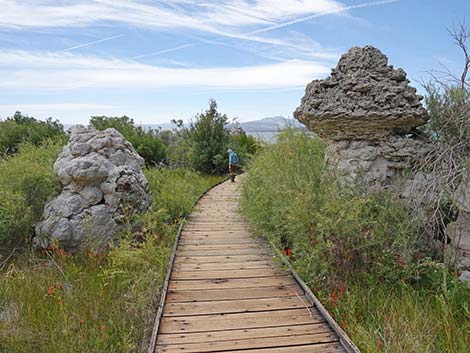 Tufa towers along the County Park Boardwalk Trail (view S) |
Location Mono Lake is located east of Highway 395, just east of Lee Vining, California. The Mono Basin Scenic Area Visitor Center is located about 0.25 miles north of Lee Vining on the east side of the road. Watch for signs on the highway. The Mono Lake County Park is located about five miles north of Lee Vining, just off Highway 395. Turn east onto Cemetery Road, and then follow it for 0.3 miles to the County Park. The parking area is adjacent to Cemetery Road. The South Tufa Area is located about 11 miles south of Lee Vining, off Highway 120. Watch for signs on Highway 395, and signs at the turnoff on Highway 120 towards "Mono Lake South Tufa." |
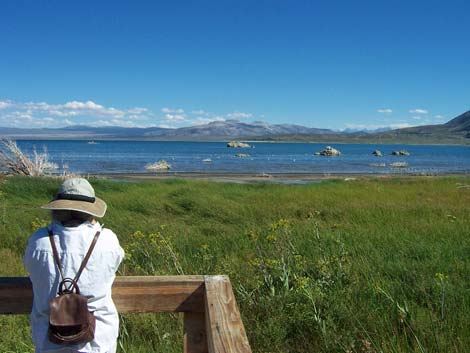 Birder at the end of the County Park Boardwalk Trail (view S) |
Hours Mono Lake is always open, but the main birding areas are day-use only. Fees South Tufa is a Federal Fee Area; adults are $3, children under 18 are free. Federal Lands Passes and Golden Age passes are valid here. Mono Lake County Park and the boardwalk trail are free, but donations are requested. |
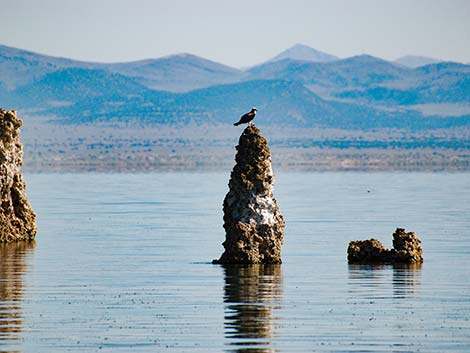 Quintessential Mono Lake: Osprey atop tufa tower (view N) |
Specialties California Gulls, Snowy Plovers, Wilson's Phalaropes, Red-necked Phalaropes, Osprey, and Eared Grebes. Many species of waterbirds and shorebirds; raptors. For More Information Visit, call, or write the Mono Basin Scenic Area Visitor Center; P.O. Box 429; Lee Vining, CA 93541; 760-647-3044. The Visitor Center has information on the geology, ecology, and human history of the area. The visitor center is located 0.25 miles north of Lee Vining. |
Mono Basin Visitor Center, National Forest Scenic Area
 Mono Basin Visitor Center, National Forest Scenic Area |
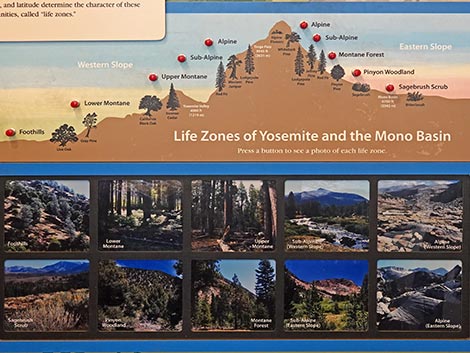 Life zones exhibit inside the visitor center -- similar to Las Vegas |
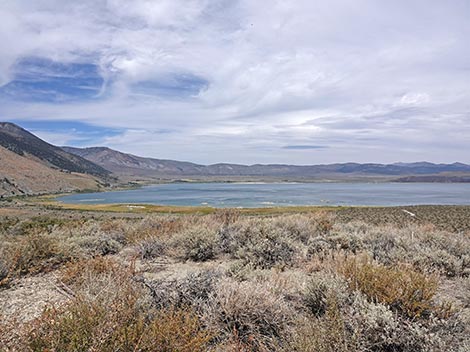 Scenery outside the visitor center (view N) |
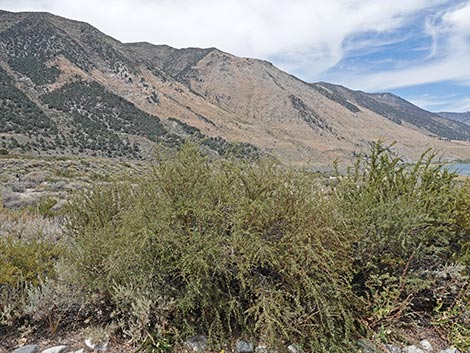 Outdoor native species plantings outside the Visitor Center |
South Tufa Towers Trail
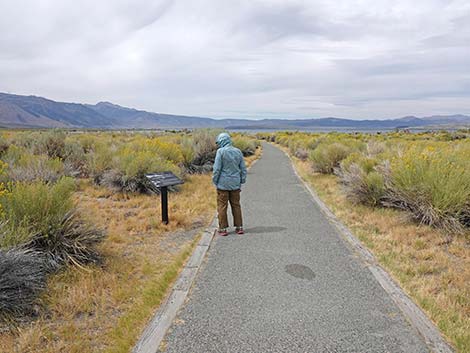 Birder starting on the South Tufa Towers Trail |
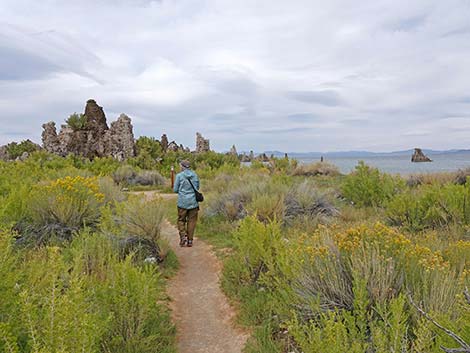 Birder on trail approaching tufa towers (view NE) |
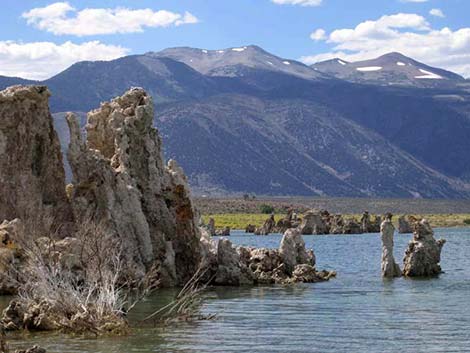 |
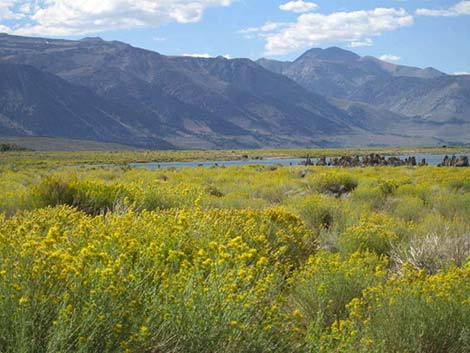 |
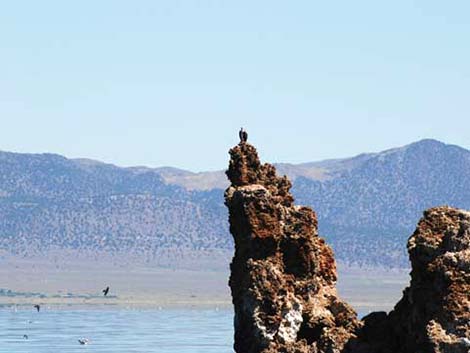 |
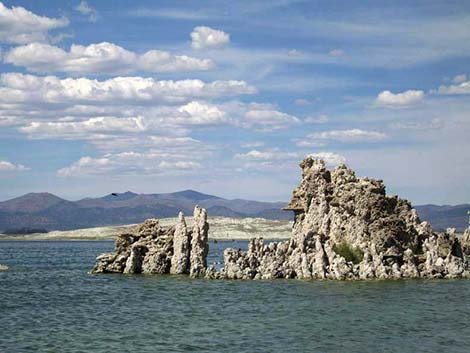 |
Mono Lake County Park and State Natural Reserve Boardwalk Trail
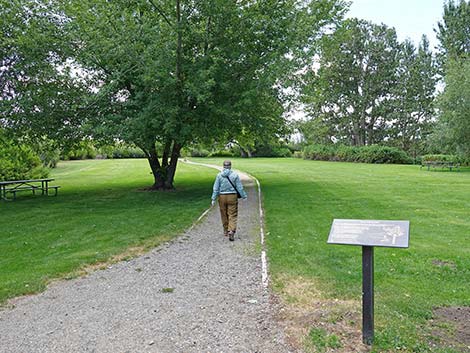 Past toilets, birder starting on gravel trail towards lake (view S) |
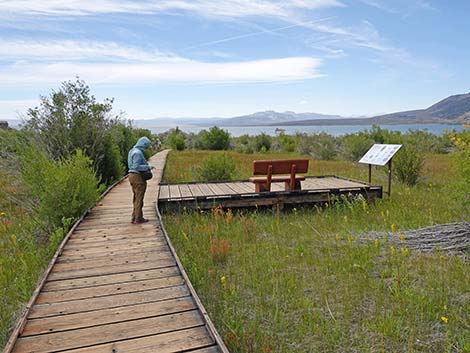 Birder inspecting the marsh vegetation (view S) |
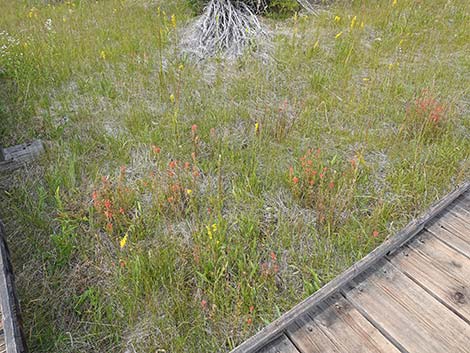 Two species of orchids and lots of other forbs (view NW) |
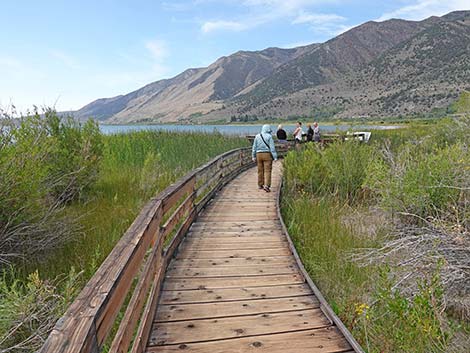 Mono Lake comes into view from the boardwalk (view S) |
Birds and other Creatures of Mono Lake
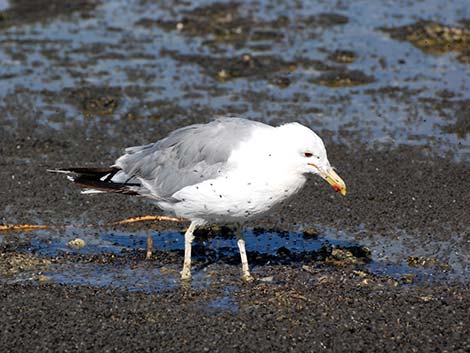 California Gull at Mono Lake with brine flies |
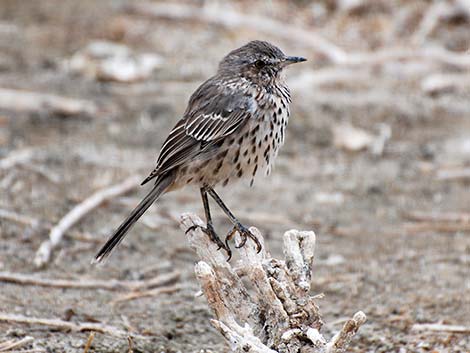 Sage Thrasher at Mono Lake |
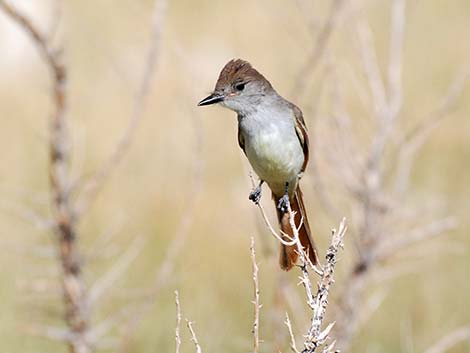 Ash-throated Flycatcher at Mono Lake |
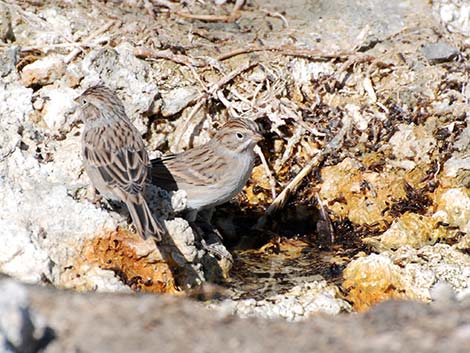 Brewers Sparrows at Mono Lake |
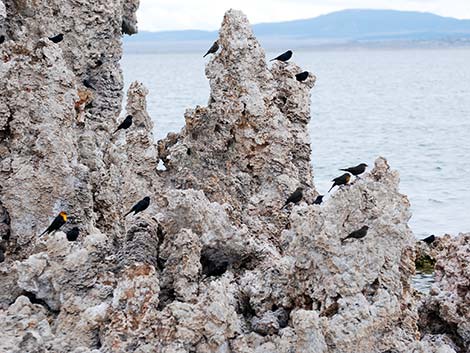 Yellow-headed Blackbirds at Mono Lake |
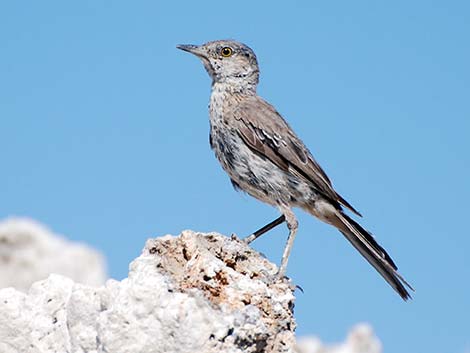 Juvenile Sage Thrasher at Mono Lake |
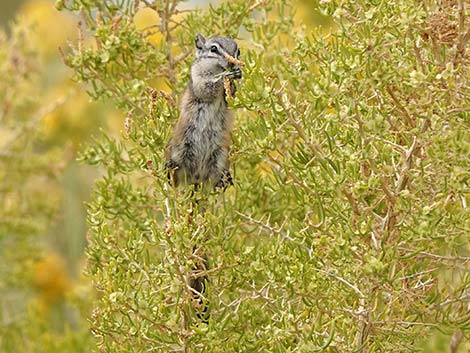 Least Chipmunk foraging on greasewood at the edge of the trail |
 Don't step on the little people (Lorquin's Admiral Butterfly) |
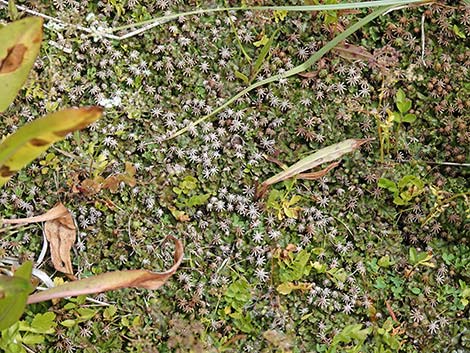 Cool non-vascular plants we missed on the way out (view down) |
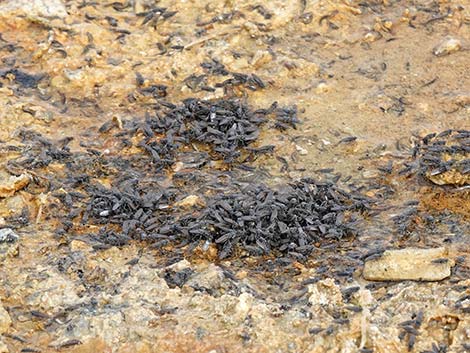 Perhaps a mating cluster of Alkali Flies (Ephydra hians) |
Happy birding! All distances, elevations, and other facts are approximate.
![]() ; Last updated 240902
; Last updated 240902
| Favorite Places Far Away | Birding Around Las Vegas | Glossary | Copyright, Conditions, Disclaimer | Home |